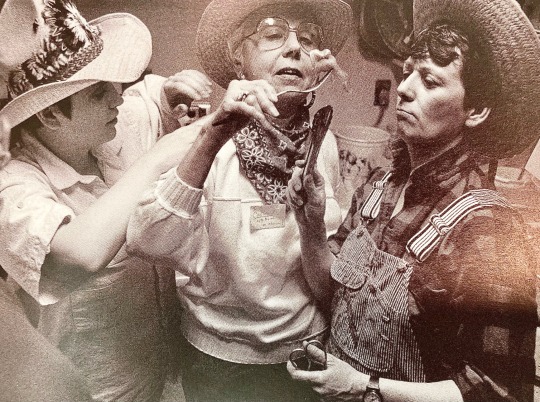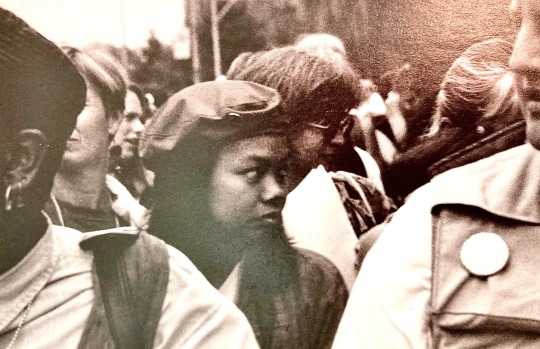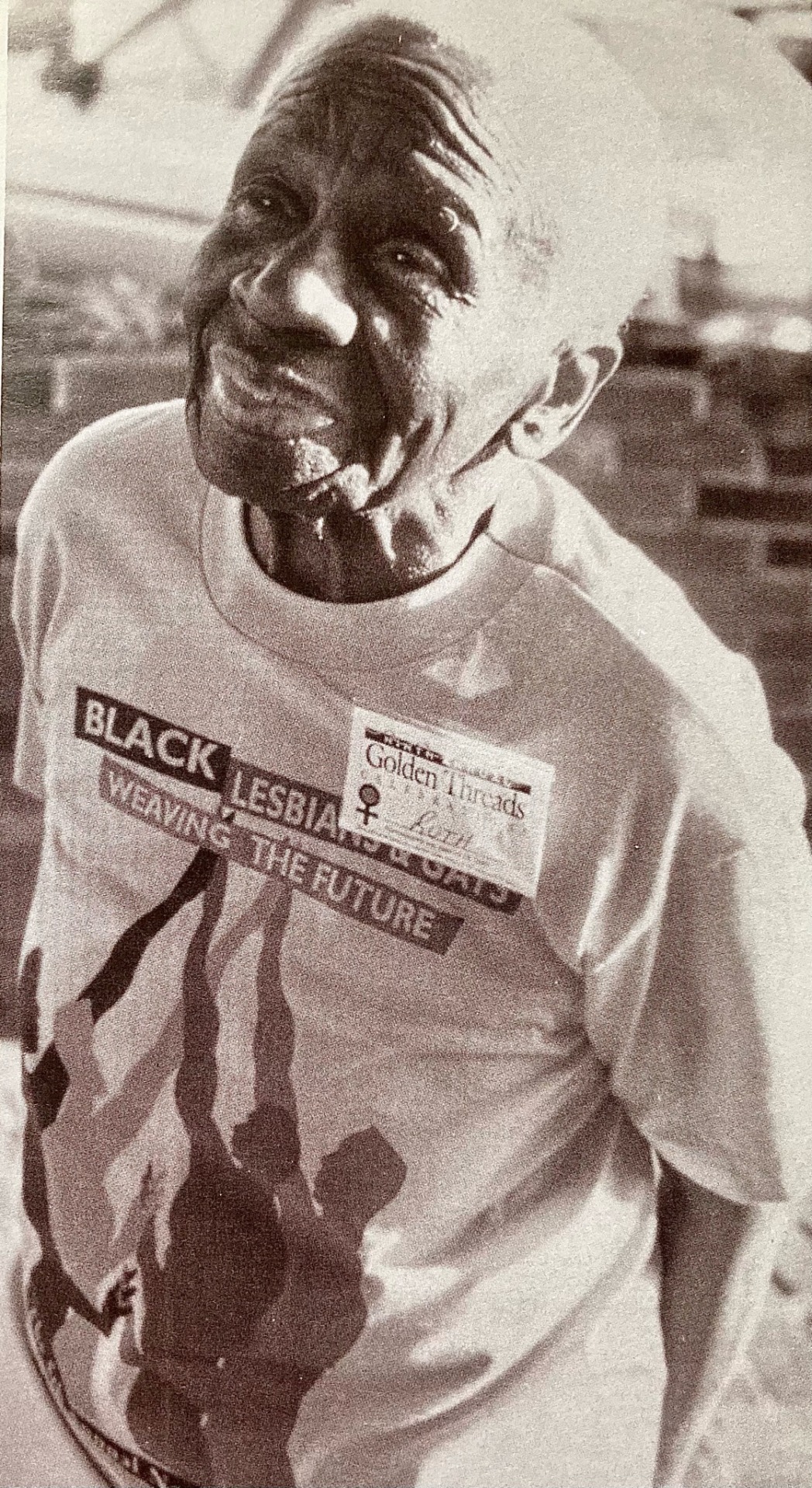#publisher: doubleday dell publishing group inc.
Text

"Dyke March 1994" by Morgan Gwenwald
source: The Wild Good: Lesbian Photographs & Writings on Love, edited by Beatrix Gates
#lesbian#lesbian literature#dyke#dyke literature#archived#thatbutcharchivist#dyke march#dyke march 1994#lesbian history#lesbian photography#author: beatrix gates#photographer: morgan gwenwald#the wild good#year: 1996#publisher: anchor books#publisher: doubleday dell publishing group inc.#butch#butch dyke#butch lesbian#why does it look alright while i'm editing and then hitting the finished button is like unleashing an entirely different monster#ai yai yai#i'll figure it out#asian lesbian
12K notes
·
View notes
Text

༅༅༅༅༅༅༅༅
In other words, it preserves the atmosphere of a diversionary ploy as a place to be, not just a place to work, so that the mind tends to be halfway between neutral and in gear.
༅༅༅༅༅༅༅༅
The Light Edit Series. EC Bliss retrofits it for the early 1980’s with a dozen or so easy steps. 100% made from Step 7: Establish an Action Environment from Doing It Now by Edwin C. Bliss, first published in 1983 by Charles Scribner’s Sons and serialized in Glamour Magazine that same year; found in a 1988 paperback edition with cover design by Malcolm Hancock published by Bantam Books, a division of Bantam Doubleday Dell Publishing Group, Inc. The above photo by Jivananda Candrāmā (James FitzGerald) was archived by name and posted prior. -Jivananda (Jim)
0 notes
Text
Sách - Clean Green Drinks by Candice Kumai (US edition, hardcover)
Sách – Clean Green Drinks by Candice Kumai (US edition, hardcover)
Ships from and sold by EXPERAL VN
Publisher: Bantam Doubleday Dell Publishing Group Inc
Origin: United States (Imported)
ISBN 13: 9780553390834
Condition: Brandnew
Binding: hardcover
Pages: 208
Dimensons: 206 x 168 x 20 | 590 (gram)
—————————————- Cleanse. Sculpt your body, boost your health, renew your mind, and improve your whole outlook on life. More than a collection of delicious recipes,…
View On WordPress
0 notes
Text
Brodavis

B. americanus by Jack Wood
Etymology: Brodkorb’s Bird
First Described By: Martin et al., 2012
Classification: Dinosauromorpha, Dinosauriformes, Dracohors, Dinosauria, Saurischia, Eusaurischia, Theropoda, Neotheropoda, Averostra, Tetanurae, Orionides, Avetheropoda, Coelurosauria, Tyrannoraptora, Maniraptoromorpha, Maniraptoriformes, Maniraptora, Pennaraptora, Paraves, Eumaniraptora, Averaptora, Avialae, Euavialae, Avebrevicauda, Pygostaylia, Ornithothoraces, Euornithes, Ornithuromorpha, Ornithurae, Hesperornithes
Referred Species: B. americanus, B. baileyi, B. mongoliensis, B. varneri
Status: Extinct
Time and Place: Between 80 and 66 million years ago, from the Campanian to the Maastrichtian ages of the Late Cretaceous


Brodavis is known from a variety of habitats, most within the Western Interior Seaway of North America, with one in Asia: the Frenchman Formation, the Hell Creek Formation, the Pierre Shale Formation, and the Nemegt Formation.

Physical Description: Brodavis was a large bird, but a small dinosaur, reaching up to 90 centimeters in body length (though some species were half that size). It had a cylindrical body and long legs, good for propelling it through the water. It had a lightly built skeleton, though, so it wasn’t well adapted to diving - and may have even still been able to fly, though not particularly well. It had a long, skinny neck, and a small head ending in a long and pointed beak. This beak was full will small, pointy teeth for catching fish. It is unclear whether or not it had webbing between its toes, but this is definitely possible. The colors of Brodavis are poorly known, but it was certainly covered with feathers all over its body.
Diet: Brodavis would have primarily eaten fish and other aquatic life.
Behavior: Being a water-based creature, Brodavis spent most of its time near the water, swimming through along the surface and looking for food. Based on other Hesperornithines, it swam mostly with its feet, propelling them like living animals such as grebes today. Its wings, which were still probably functional, would have not been used in the water. Still, given the presence of flight in Brodavis, it probably would have been able to take off from the water to avoid danger - and back to the water to avoid more danger still, given the large predatory dinosaurs it shared habitats with. It would have then gone to the coasts to rest and rejoin other Brodavis, and would have also had nests there that they had to take care of. How social it was, or other specifics on behavior, are unknown at this time - though it would not be surprising if they lived in large family groups, given how common such behavior is in modern aquatic birds and the fact that it’s a fairly common genus of dinosaur.

B. varneri By Scott Reid
Ecosystem: Being known from a wide variety of habitats, it’s nearly impossible to completely describe everything Brodavis ever lived with in one dinosaur article. That being said, Brodavis tended to live along the coast of major waterways (especially in freshwater areas), where it would spend most of its time underwater but go back to the shores to rest, mate, and take care of their young. Since Brodavis was found both in the Western Interior Seaway and the Seaway of Eastern Asia, it probably would have encountered a wide variety of other dinosaurs. In the Canadian Frenchman Formation, for example, it would have encountered the small herbivore Thescelosaurus, the large hadrosaur Edmontosaurus, the horned dinosaurs Triceratops and Torosaurus, the ostrich-like Ornithomimus, and the large predator Tyrannosaurus. In Hell Creek the companions of Brodavis were many, but included other dinosaurs like Tyrannosaurus, Ornithomimus, Triceratops, Torosaurus, Edmontosaurus, and Thescelosaurus like the Frenchman Formation - but also ankylosaurs like Denversaurus and Ankylosaurus, pachycephalosaurs like Sphaerotholus and Pachycephalosaurus, the small ceratopsian Leptoceratops, another ostrich-like dinosaur Struthiomimus, the chickenparrot Anzu, the raptor Acheroraptor, the opposite bird Avisaurus, and the modern bird Cimolopteryx - and more! In the Pierre Shale, Brodavis was accompanied by other Hesperornithines like Baptornis and Hesperornis. And, finally, in the Nemegt, Brodavis lived with another Hesperornithine Judinornis, the duck Teviornis, the ankylosaur Tarchia, the hadrosaur Saurolophus, the pachycephalosaurs Prenocephale and Homalocephale, the titanosaur Nemegtosaurus, the tyrannosaurs Alioramus and Tarbosaurus, Duck Satan Himself Deinocheirus, the ostrich-mimics Anserimimus and Gallimimus, the alvarezsaur Mononykus, the therizinosaur Therizinosaurus, the chickenparrots Avimimus, Elmisaurus, Nomingia, and Nemegtomaia; the raptor Adasaurus, and the troodontid Zanabazar. Given this wide variety of habitats and neighbors, Brodavis was probably able to live in freshwater habitats, unlike other hesperornithines, and it was decidedly a very adaptable dinosaur.

B. baileyi by Scott Reid
Other: Brodavis represents a unique group of Hesperornithines, though it’s possible the genus is overlumped, which would make the family that currently only has Brodavis in it (Brodavidae) actually informative.
Species Differences: These species differ mainly on where they’re from - B. americanus from the Frenchman Formation, B. baileyi from the Hell Creek Formation, B. mongoliensis from the Nemegt, and B. varneri from the Pierre Shale. As such, B. varneri is the oldest of the four, and may be its own genus. It is also the best known species.
~ By Meig Dickson
Sources under the Cut
Aotsuka, K. and Sato, T. (2016). Hesperornithiformes (Aves: Ornithurae) from the Upper Cretaceous Pierre Shale, Southern Manitoba, Canada. Cretaceous Research, (advance online publication).
Bakker, R. T., Sullivan, R. M., Porter, V., Larson, P. and Saulsbury, S. J. (2006). "Dracorex hogwartsia, n. gen., n. sp., a spiked, flat-headed pachycephalosaurid dinosaur from the Upper Cretaceous Hell Creek Formation of South Dakota". in Lucas, S. G. and Sullivan, R. M., eds., Late Cretaceous vertebrates from the Western Interior. New Mexico Museum of Natural History and Science Bulletin 35, pp. 331–345.
Boyd, Clint A.; Brown, Caleb M.; Scheetz, Rodney D.; Clarke; Julia A. (2009). "Taxonomic revision of the basal neornithischian taxa Thescelosaurus and Bugenasaura". Journal of Vertebrate Paleontology. 29 (3): 758–770.
Campione, N.E. and Evans, D.C. (2011). "Cranial Growth and Variation in Edmontosaurs (Dinosauria: Hadrosauridae): Implications for Latest Cretaceous Megaherbivore Diversity in North America." PLoS ONE, 6(9): e25186.
Carpenter, K. (2003). "Vertebrate Biostratigraphy of the Smoky Hill Chalk (Niobrara Formation) and the Sharon Springs Member (Pierre Shale)." High-Resolution Approaches in Stratigraphic Paleontology, 21: 421-437.
Estes, R.; Berberian, P. (1970). "Paleoecology of a late Cretaceous vertebrate community from Montana". Breviora. 343.
Glass, D.J., editor, 1997. Lexicon of Canadian Stratigraphy, vol. 4, Western Canada. Canadian Society of Petroleum Geologists, Calgary, Alberta, 1423.
Gradzinski, R., J. Kazmierczak, J. Lefeld. 1968. Geographical and geological data form the Polish-Mongolian Palaeontological Expeditions. Palaeontologia Polonica 198: 33 - 82.
Henderson, M.D.; Peterson, J.E. (2006). "An azhdarchid pterosaur cervical vertebra from the Hell Creek Formation (Maastrichtian) of southeastern Montana". Journal of Vertebrate Paleontology. 26 (1): 192–195
Jerzykiewicz, T., D. A. Russell. 1991. Late Mesozoic stratigraphy and vertebrates of the Gobi Basin. Cretaceous Research 12 (4): 345 - 377.
Kielan-Jaworowska, Z., R. Barsbold. 1972. Narrative of the Polish-Mongolian Palaeontological Expeditions 1967-1971. Palaeontologia Polonica 27: 5 - 136.
Lerbekmo, J.F., Sweet, A.R. and St. Louis, R.M. 1987. The relationship between the iridium anomaly and palynofloral events at three Cretaceous-Tertiary boundary localities in western Canada. Geological Society of America Bulletin, 99:25-330.
Longrich, N. (2008). "A new, large ornithomimid from the Cretaceous Dinosaur Park Formation of Alberta, Canada: Implications for the study of dissociated dinosaur remains". Palaeontology. 54 (1): 983–996.
Longrich, N.R., Tokaryk, T. and Field, D.J. (2011). "Mass extinction of birds at the Cretaceous–Paleogene (K–Pg) boundary." Proceedings of the National Academy of Sciences, 108(37): 15253-15257.
Novacek, M. 1996. Dinosaurs of the Flaming Cliffs. Bantam Doubleday Dell Publishing Group Inc. New York, New York.
Martin, L. D., E. N. Kurochkin, T. T. Tokaryk. 2012. A new evolutionary lineage of diving birds from the Late Cretaceous of North America and Asia. Palaeoworld 21: 59 - 63.
Martyniuk, M. P. 2012. A Field Guide to Mesozoic Birds and other Winged Dinosaurs. Pan Aves; Vernon, New Jersey.
Pearson, D. A.; Schaefer, T.; Johnson, K. R.; Nichols, D. J.; Hunter, J. P. (2002). "Vertebrate Biostratigraphy of the Hell Creek Formation in Southwestern North Dakota and Northwestern South Dakota". In Hartman, John H.; Johnson, Kirk R.; Nichols, Douglas J. (eds.). The Hell Creek Formation and the Cretaceous-Tertiary boundary in the northern Great Plains: An integrated continental record of the end of the Cretaceous. Geological Society of America. pp. 145–167.
Tokaryk, T. 1986. Ceratopsian dinosaurs from the Frenchman Formation (Upper Cretaceous) of Saskatchewan. Canadian Field-Naturalist 100:192–196.
Varricchio, D. J. 2001. Late Cretaceous oviraptorosaur (Theropoda) dinosaurs from Montana. pp. 42–57 in D. H. Tanke and K. Carpenter (eds.), Mesozoic Vertebrate Life. Indiana University Press, Indianapolis, Indiana.
Watabe, M., S. Suzuki, K. Tsogtbaatar, T. Tsubamoto, M. Saneyoshi. 2010. Report of the HMNS-MPC Joint Paleontological Expedition in 2006. Hayashibara Museum of Natural Sciences Reasearch Bulletin 3:11 - 18.
Weishampel, David B.; Dodson, Peter; and Osmólska, Halszka (eds.): The Dinosauria, 2nd, Berkeley: University of California Press. 861 pages.
#Brodavis#Euornithine#Hesperornithine#Bird#Dinosaur#Theropod Thursday#Piscivore#North America#Eurasia#Cretaceous#Brodavis americanus#factfile#Brodavis baileyi#Brodavis mongoliensis#Brodavis varneri#Birds#Dinosaurs#prehistoric life#paleontology#prehistory#birblr#palaeoblr#biology#a dinosaur a day#a-dinosaur-a-day#dinosaur of the day#dinosaur-of-the-day#science#nature
182 notes
·
View notes
Text
2 notes
·
View notes
Text
Thou Shalt Know Him
John Sawyer
Bedford Presbyterian Church
1 / 19 / 20
John 1:29-42
Psalm 40
“Thou Shalt Know Him”
(When You Know, You Know)
As some of you know, I love playing guitar. I love playing guitar, looking at guitars – and, when I can, buying guitars and other guitar-related-stuff.
If you were to ask anybody who is passionate about guitar – or any other musical instrument – who is looking for a brand new (or, new-to-them) instrument to play and to own, in the best of all circumstances, they might be able to go into a music store to try out a bunch of instruments, one right after the other. An experienced player could try five, or ten, or twenty different instruments in a row, and, in the end, one or two particular instruments would likely rise to the top of the heap until they finally narrow it down to “The One.” And, they will usually know, in an instant, that they have found it. They will play a certain chord or note and get a certain, special kind of sound. And, when they hear it and feel it, they will know that they have found “The One.”
Now, it should be noted, alas, that when it comes to musical instruments, “The One” usually comes with a higher price tag, but not always. When you find “The One,” though, the joy that you get in the moment is often worth any price. When you know, you know.
Many of you have probably had a “when you know, you know” experience. You walk onto the campus of the college you will end up attending or walk into a house that you will end up buying and say, “Yes! This is the place where I need to be” because it just feels right, and is right. Maybe, you walk into a room and come face-to-face with the person you will end up marrying, and say, “Ah! Yes! This is the person.” And, you know that it just feels right. Just as an aside, when it comes to meeting “The One,” it always helps when the other person is thinking and feeling the same way that you are.
There are times in life when you just know – the right thing comes along, the right place comes along, the right person comes along – and things feel right, and look right, and taste and smell and sound right, and, you just know. . . you know?
In today’s reading from the Gospel of John, we are given a glimpse into a couple of key moments when things just feel right – when people encounter Jesus and they just. . . know.
If you remember from last Sunday, John the Baptizer was down by the Jordan River and lots of people came out from the cities and countryside to see him and to be washed – baptized – by him in the river. Jesus also came to be baptized and, last week we heard the story of how it happened. Just so you know, all four gospels talk about the baptism of Jesus, but where Matthew, Mark, and Luke all tell the story of what happened when Jesus went down into the water,[1] in John’s version, we only hear about it from John the Baptizer after-the-fact:
“I was there,” John says, “and I saw the Spirit descending from heaven like a dove, and it remained on Jesus. The whole reason I am out here baptizing people with water is so that I could be on the lookout for this to happen. I, myself, did not know Jesus, but when I saw the Spirit descend upon him, I knew. . . I have seen the proof that this he is the Lamb of God who takes away the sin of the world. This is the Son of God.”[2]
Just so you know, when John talks about the “Lamb of God,” he is using some ancient imagery from what we call the Old Testament, talking about sacrifice[3] and servanthood.[4] John is saying that not only is Jesus the sacrificial servant of God, Jesus is also the Son of God – a title that comes out of the Old Testament for a great king, an exalted person, a holy figure, the Messiah.[5]
Now, this is a bold claim for John to make. For generations, the people of Israel had been looking and watching and waiting for the Messiah, God’s chosen one, who would bring salvation to God’s people. Would the Messiah ever appear? What would it be like? Who would it be? Right before today’s passage, the religious leaders from up in Jerusalem send priests down to see John. “Who are you?” they ask. “I am not the Messiah,” he says, right off the bat, “I am the voice crying out in the wilderness, saying, ‘People, get ready. God is coming’”[6]
John lifts up his voice in the wilderness and puts it to good use in today’s passage when he tells the story of what he saw when Jesus was baptized. In some miraculous and holy way, John has seen the Holy Spirit descend and “remain” or “dwell, lodge, abide”[7] on and with Jesus. We don’t know exactly what this looked like. John says that it was like a dove that descended from heaven and rested on Jesus. Of course, unless they’re a pirate, the thought of some guy walking around with a bird sitting on them is a bit odd, to say the least. To be true, there might not have been an actual bird that landed on Jesus. It’s just language that John used to describe something indescribable. There must have been something about the way that John saw Jesus that day, and he just knew that God was present in a way that had been previously unknown in the world. When John saw, he knew. And, he wanted others to know, too. When you know, you know. . . you know?
Believe it or not, John the Baptizer had some disciples – people who followed him and learned from him. There are several references in the New Testament to the disciples of John. A day or so after Jesus had been baptized, John is standing with two of his own disciples – Andrew and another guy (we don’t know his name). And, when Jesus walks by, John says, “Look, here he is: the Lamb of God – the sacrificial servant Messiah!” Upon hearing this, the two disciples who are hanging out with John leave him and they start to follow Jesus.
The story then shifts, from John’s perspective to the perspective of these two disciples – Andrew and the other guy. When Jesus turns and sees them following, he asks them, “What are you looking for?” In the original language, this question could also be translated as, “What are you seeking? What are you striving for, wishing for, aiming for? What do you want?”[8]
In the moment, Andrew and the other guy say, “Rabbi (which means teacher).” It is clear to them that this person upon whom the Spirit is abiding has something to teach them, something holy and true and pure. They see Jesus and they just. . . know.
I have often wondered what it was about Jesus that caused people to just know. I mean, there are plenty of examples in the Bible of Jesus doing signs and wonders and miracles and people seeing, and believing in him, but in today’s story, we hear second-hand from John about the Holy Spirit coming to rest on Jesus. And then, Jesus is just walking along and these guys start following him, based on something they heard about him.
If you think about it, though, this is where we find ourselves – gathered together on a chilly January day, hearing stories about someone who lived so long ago. And yet, for some reason, based on what we have heard about him, we plowed out our driveways and scraped ice off of our cars and came here this morning. If we’re honest, though, most people don’t follow Jesus based, simply, on something they have heard. There is more. . . There is something that happens at the heart of who they are. And, when they know, they know. There is an old poem that speaks to this in a beautiful way:
Thou shalt know him when he comes,
Not by any din of drums,
Nor his manners, nor his airs,
Nor by any thing he wears.
Thou shalt know him when he comes,
Not by a crown nor by a gown,
But his coming known shall be,
By the holy harmony
Which his coming makes in thee.
Thou shalt know him when he comes.[9]
To put it another way, the way that we come to know Jesus is not because of any outward sign – not by the way he looks or acts – but through something that happens within us. . . a “holy harmony” at the heart of who we are. There are people in this world – and you and I might just be some of these people – who are able to say that despite all of the wrong that we see, all of the doubts we might have, all of the sin and darkness we might carry, when it comes to Jesus, we just know. . . that we are loved, that we are accepted, that we are healed and made whole, that we are forgiven and set free. And, like those first two disciples who got up and followed, we know that there is much that we do not know, but we trust that Jesus can teach us. . . how to live, how to offer ourselves to others, how to follow because there is no other way to find the harmony that Christ offers.
Now, I know that not everyone feels this way about Jesus or trusts that he is the One to bring harmony to our lives and to the life of the world. But I do know that everyone – whether they trust in Jesus or not – is longing for harmony in some way, shape, or form. There are so many instruments to try. And we might – over the course of our lives – try to play them all in search of “The One” that offers the right tone – that special something that says, “This is The One.”
You know, the very first words that are spoken by Jesus in the Gospel of John are “What are you looking for?” The Word that became flesh[10] begins with a question, starting a conversation with us, offering a kind and gracious invitation to us, giving us the opportunity to just. . . know. And, if we don’t just know. . . or don’t know, yet, may the invitation of Jesus serve as a glimpse into the harmony that he offers – a tiny epiphany in this season called Epiphany that is all about the ways that Jesus Christ is revealed to us.
When you know, you know. And, if you don’t know yet, you will know him when he comes.
In the name of the Father, and of the Son, and of the Holy Spirit. Amen.
----------
[1] See Matthew 3, Mark 1, and Luke 3.
[2] John 1:29-34. Paraphrased, JHS.
[3] See Leviticus 4-5.
[4] See Isaiah 53:7.
[5] David Noel Freedman, ed. The Anchor Bible Dictionary – Vol. 6 - Si-Z (New York: Doubleday Dell Publishing Group, Inc., 1992) “Son of God,” 128 – VI.
[6] John 1:19-20, 23. Paraphrased, JHS.
[7] Walter Bauer, A Greek-English Lexicon of the New Testament and Other Early Christian Literature (Chicago: University of Chicago Press, 1979) 503.
[8] Bauer, 338-339.
[9] Poem by an anonymous 15th Century author. https://libearyn.wordpress.com/2016/12/09/thou-shalt-know-him/.
[10] John 1:14.
0 notes
Text
Bronnen
Achternaam, voornaam. Titel. Editie. Plaats van uitgave: naam uitgever, jaar van uitgave. Print
Webpagina’s:
Boeken:
G. Jung, Carl. Man and His Symbols. 1e druk. New York: Bantam Doubleday Dell Publishing Group Inc, 1997
Evans, Jules. The Art of Losing Control, A Philosopher’s Search for Ecstatic Experience.
Kunstwerken:
Youtube:
0 notes
Text

"Christopher Street, NYC, 1988" by Kathryn Kirk
source: The Wild Good: Lesbian Photographs & Writings On Love, edited by Beatrix Gates
#lesbian#lesbian literature#dyke#dyke literature#archived#thatbutcharchivist#butch#butch dyke#butch lesbian#femme#femme dyke#femme lesbian#femme4butch#butch4femme#femme butch#lesbian history#lesbian photography#lesbian books#the wild good#author: beatrix gates#year: 1996#publisher: doubleday dell publishing group inc.#publisher: anchor books#photographer: kathryn kirk
1K notes
·
View notes
Text

"Louise Fishman," photographed by Betsy Crowell
source: The Wild Good: Lesbian Photographs & Writings on Love, edited by Beatrix Gates
#lesbian literature#lesbian#dyke#archived#thatbutcharchivist#lesbian books#lesbian photography#butch lesbian#butch dyke#butch#louise fishman#photographer: betsy crowell#the wild good#year: 1996#author: beatrix gates#publisher: doubleday dell publishing group inc.#publisher: anchor books
335 notes
·
View notes
Text

"Lesbian Rights March, September 1995, People's Republic of China" by Ann Meredith
source: The Wild Good: Lesbian Photographs & Writings on Love, edited by Beatrix Gates
#power lesbian is such a damn good shirt#black lesbian#black lesbian history#black history#lesbian rights march#lesbian history#poc lesbian history#lesbian literature#lesbian books#lesbian photography#lesbian#dyke#archived#thatbutcharchivist#photographer: ann meredith#author: beatrix gates#year: 1996#the wild good#publisher: doubleday dell publishing group inc.#publisher: anchor books
386 notes
·
View notes
Text

Photograph by Vita C. Shapiro
source: The Wild Good: Lesbian Photographs & Writings on Love, edited by Beatrix Gates
#lesbian literature#lesbian#dyke#archived#thatbutcharchivist#lesbian photography#lesbian history#lesbian books#author: beatrix gates#photographer: vita c. shapiro#the wild good#year: 1996#publisher: doubleday dell publishing group inc.#publisher: anchor books
369 notes
·
View notes
Text

"Tasters" by Margaret Randall
source: The Wild Good: Lesbian Photographs and Writings on Love, edited by Beatrix Gates
#lesbian literature#lesbian#dyke#archived#thatbutcharchivist#lesbian books#lesbian history#lesbian photography#butch#butch lesbian#butch dyke#year: 1996#the wild good#author: beatrix gates#photographer: margaret randall#publisher: doubleday dell publishing group inc.#publisher: anchor books
187 notes
·
View notes
Text

"Audre Lorde and friends" by Jean Weisinger
source: The Wild Good: Lesbian Photographs and Writings on Love, edited by Beatrix Gates
#lesbian literature#lesbian#dyke#archived#thatbutcharchivist#lesbian books#lesbian history#lesbian photography#audre lorde#black lesbian#black lesbian history#year: 1996#the wild good#author: beatrix gates#photographer: jean weisinger#publisher: doubleday dell publishing group inc.#publisher: anchor books
191 notes
·
View notes
Text

"Lesbian Rights March, September 1995, People's Republic of China" (Photographed by Ann Meredith)
source: The Wild Good: Lesbian Photographs and Writings on Love, edited by Beatrix Gates
#lesbian literature#lesbian#dyke#thatbutcharchivist#archived#lesbian books#lesbian photography#lesbian history#year: 1996#publisher: doubleday dell publishing group inc.#publisher: anchor books#photographer: ann meredith#author: beatrix gates#people's republic of china#lesbian rights march#poc lesbian#asian lesbian#(presumably ughhhhhh i hate potential inaccuracy lol)
90 notes
·
View notes
Text

"Ruth Ellis, Golden Threads Celebration 1995," from the documentary Golden Threads
source: The Wild Good: Lesbian Photographs & Writings on Love, edited by Beatrix Gates
#ruth looks so so cute 😭😭😭😭#black lesbians & gays weaving the future#is what her shirt says#ruth ellis#golden threads documentary#golden threads#lesbian literature#lesbian#dyke#archived#thatbutcharchivist#black lesbian history#black lesbian#poc lesbian#poc lesbian history#photographer: marian roth#wildlight productions#the wild good#year: 1996#author: beatrix gates#publisher: doubleday dell publishing group inc.#publisher: anchor books#lesbian history#old lesbian#lesbian elder#lesbian books#lesbian photography#black sapphic#black sapphic history#black history
108 notes
·
View notes
Text

"five months" by Jean Weisinger
source: The Wild Good: Lesbian Photographs and Writings on Love, edited by Beatrix Gates
#lesbian literature#lesbian#dyke#archived#thatbutcharchivist#lesbian books#lesbian history#lesbian photography#black lesbian#black sapphic#year: 1996#the wild good#author: beatrix gates#photographer: jean weisinger#publisher: doubleday dell publishing group inc.#publisher: anchor books
116 notes
·
View notes